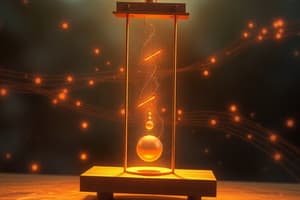Podcast
Questions and Answers
What is the definition of periodic time (T) in the context of a simple pendulum?
What is the definition of periodic time (T) in the context of a simple pendulum?
- The time taken for the pendulum to complete half an oscillation.
- The time taken to make one complete oscillation. (correct)
- The total time taken to swing back and forth once.
- The time taken for the pendulum to return to its original position.
How does the length of the pendulum (L) affect the period (T) of the pendulum's oscillation?
How does the length of the pendulum (L) affect the period (T) of the pendulum's oscillation?
- Shorter lengths result in longer periods.
- Longer lengths result in longer periods. (correct)
- The length has no effect on the period.
- Longer lengths result in shorter periods.
Which formula represents the angular velocity (ω) in relation to the period (T)?
Which formula represents the angular velocity (ω) in relation to the period (T)?
- ω = 2π/L
- ω = 2π/T (correct)
- ω = 2πT
- ω = T/2π
Which statement best describes the formula for acceleration (a) in a simple pendulum?
Which statement best describes the formula for acceleration (a) in a simple pendulum?
In the procedure for determining the acceleration due to gravity, what is measured after releasing the pendulum bob?
In the procedure for determining the acceleration due to gravity, what is measured after releasing the pendulum bob?
Which components are required to set up a simple pendulum experiment?
Which components are required to set up a simple pendulum experiment?
What is the correct relationship between frequency (v) and period (T)?
What is the correct relationship between frequency (v) and period (T)?
What is the primary factor that determines the slope of the plot when graphing T versus L?
What is the primary factor that determines the slope of the plot when graphing T versus L?
How should the pendulum be displaced to ensure harmonic motion is observed?
How should the pendulum be displaced to ensure harmonic motion is observed?
Flashcards
Simple Pendulum
Simple Pendulum
A small metallic ball suspended by a string, swinging back and forth.
Simple Harmonic Motion
Simple Harmonic Motion
Repeating movement with a constant period.
Periodic Time (T)
Periodic Time (T)
Time taken for one complete oscillation.
Angular Velocity (𝜔)
Angular Velocity (𝜔)
Signup and view all the flashcards
Frequency (v)
Frequency (v)
Signup and view all the flashcards
Acceleration Due to Gravity (g)
Acceleration Due to Gravity (g)
Signup and view all the flashcards
Period of Oscillation (T)
Period of Oscillation (T)
Signup and view all the flashcards
Length of Pendulum (L)
Length of Pendulum (L)
Signup and view all the flashcards
20 Complete Oscillations
20 Complete Oscillations
Signup and view all the flashcards
Plotting T vs L
Plotting T vs L
Signup and view all the flashcards
Study Notes
Objective
- Determine acceleration due to gravity using simple pendulum's harmonic motion
Apparatus
- Metal holder
- String
- Small ball
- Stop watch
- Meter rule
Theory
- Simple pendulum = small metallic ball suspended by string
- String's length = L
- Attached to support stand by clamp
- Motion is harmonic (swinging back and forth)
Simple Harmonic Motion
- Repeats itself every specific time period
- Periodic Time (T) = time for one complete oscillation
Angular Velocity (ω)
- ω = 2π/T
Frequency (ν)
- ν = 1/T
Formula
- T² = 4π²L/g (relevant for experiment, L = length, g = acceleration due to gravity)
Procedure
- Suspend metallic ball with 1 meter string to a stand
- Displace ball slightly
- Measure time for 20 complete oscillations
- Increase string length by 10 cm, repeat measurements, up to approximately 1 meter
- Calculate oscillation period for each length (total time / 20)
- Record observations (L, T) in table
Graph
- Plot relation between T² and L
- Calculate acceleration due to gravity (g) from graph slope (m = 4π²/g = BC/AC); where BC and AC are on the graph)
Conclusion
- Find value of acceleration due to gravity (g) from graph
Studying That Suits You
Use AI to generate personalized quizzes and flashcards to suit your learning preferences.




